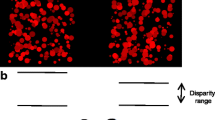Abstract
THE relation between peripheral and foveal vision and the extent to which scanning movements of the eyes are necessary in the perception of three-dimensional space are problems of long standing. Experimental work on stereoscopic vision has been largely concerned with the measurement of stereoscopic acuity, using the three-needle test or one of its modifications, under carefully controlled conditions. Such tests give the minimum resolvable difference in depth which can be perceived by an observer under the given conditions; but they do not explain how the eyes function when they view the normal three-dimensional world. In normal observation of space the point of fixation ranges over a wide field, and the eyes are continuously receiving dissimilar uniocular impressions. It is generally assumed, however, that stereoscopic vision is based upon the stimulation of disparate retinal points, so that consequent on the presentation of unequal uniocular impressions the final perceptual pattern in space is determined by the retinal disparity from purely geometrical considerations. The experiments which are to be described show that this simple geometrical theory does not hold generally, but only if the space object forms an image entirely on the fovea.
Similar content being viewed by others
Author information
Authors and Affiliations
Rights and permissions
About this article
Cite this article
ADAMSON, J. Ocular Scanning and Depth Perception. Nature 168, 345–346 (1951). https://doi.org/10.1038/168345a0
Issue Date:
DOI: https://doi.org/10.1038/168345a0
- Springer Nature Limited
This article is cited by
-
Stereoscopic acuity in ocular pursuit of moving objects
Documenta Ophthalmologica (1991)





